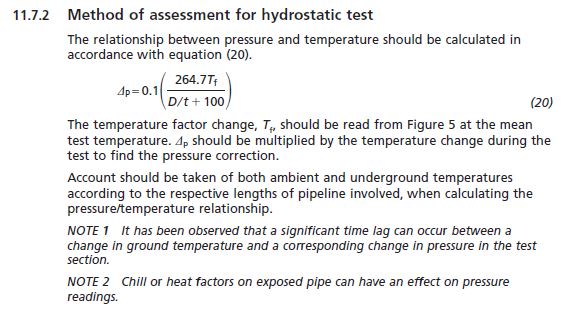@Little Inch
The Hydrotests are conducted on Natural Gas Transmission pipelines.
My pipelines are regulated by 49 CFR Part 192. I've been relying on the Pipeline Rules of Thumb Handbook for my volume calculations for validating that there are no leaks. With that, I've used a method I learned for calculating the propagation of uncertainty called the Kline Mcclintock method. Also, it is the only method I know of to calculate uncertainty given a single data point. Maybe it is naive and impractical to achieve what I'm trying, but in pursuit of knowledge I've decided I'd at least try to accomplish it. I've searched these forums for months for this answer and no one even mentions uncertainty associated with measuring equipment. API 1110 references AS/NZS 2885:5:2012 for methodologies but my superior struck me down saying they don't want to use a foreign standard (like how do you fight that logic??). I've actually never heard of BS PD 8010, but I'll try finding it. Unfortunately, it may end the same way as me trying to acquire AS/NZS 2885:5:2012.
As for the long pipelines will not achieve uniform temperature, I will admit that I don't have any working experience with actual Hydrotests, but many documents and information shared with me suggests that variation of temperature for buried pipe is very small (most of my pipelines are buried by the way, I should've mentioned that). If there were notable temperature variations (going through a lake), could a second temperature probe be applied and then a weight average be used? Now practically, that may be a waste of time if the pipe in the lake is a small section of the test section.
I've acquired a testing procedure from the California State Lands Commission that has very stringent requirements for Hydrotesting. Much of what it says mirrors what I'm saying, and if I remember correctly they require all Hydrotests to be approved by them. Now that procedure is much stricter than what is required of us, but if there isn't too much of a cost burden, then I'd like to improve our process. They also have a spreadsheet that they use to validate the test. If you ask for it nicely, they will provide a free copy of it to you (or if you curious as to what it looks like I can send you a copy @LI). I'll attach the procedure so you can see what I'm talking about.
Perhaps the whole idea of what I'm doing doesn't conform to the idea of just pumping out as much successful Hydrotests so we can keep the project moving forward, but I'd like to believe that operators should do everything within their power to make sure they're operating safely. If it's just a couple hundred bucks more per Hydrotests (cost of improved temperature sensors), I feel like it should be expected to take that extra step (from what I've been told these Hydrotests can cost around $500k).
I've been reading a lot of your posts @LI and I'm glad you replied to mine. I respect the engineering thought process you go through and I've learned a lot these past few months just reading through these forums.
NOTE: I don't have any practical experience with Hydrotests. All I know is what I've been told and what I've been able to ascertain while reading through these forums and other online resources. Unfortunately that doesn't make me quite qualified to come up with a solution on my own. Let me know if any ideas I have may be incorrect or based on false assumptions.
Thanks,
Smitty
Smitty



![[sadeyes] [sadeyes] [sadeyes]](/data/assets/smilies/sadeyes.gif)